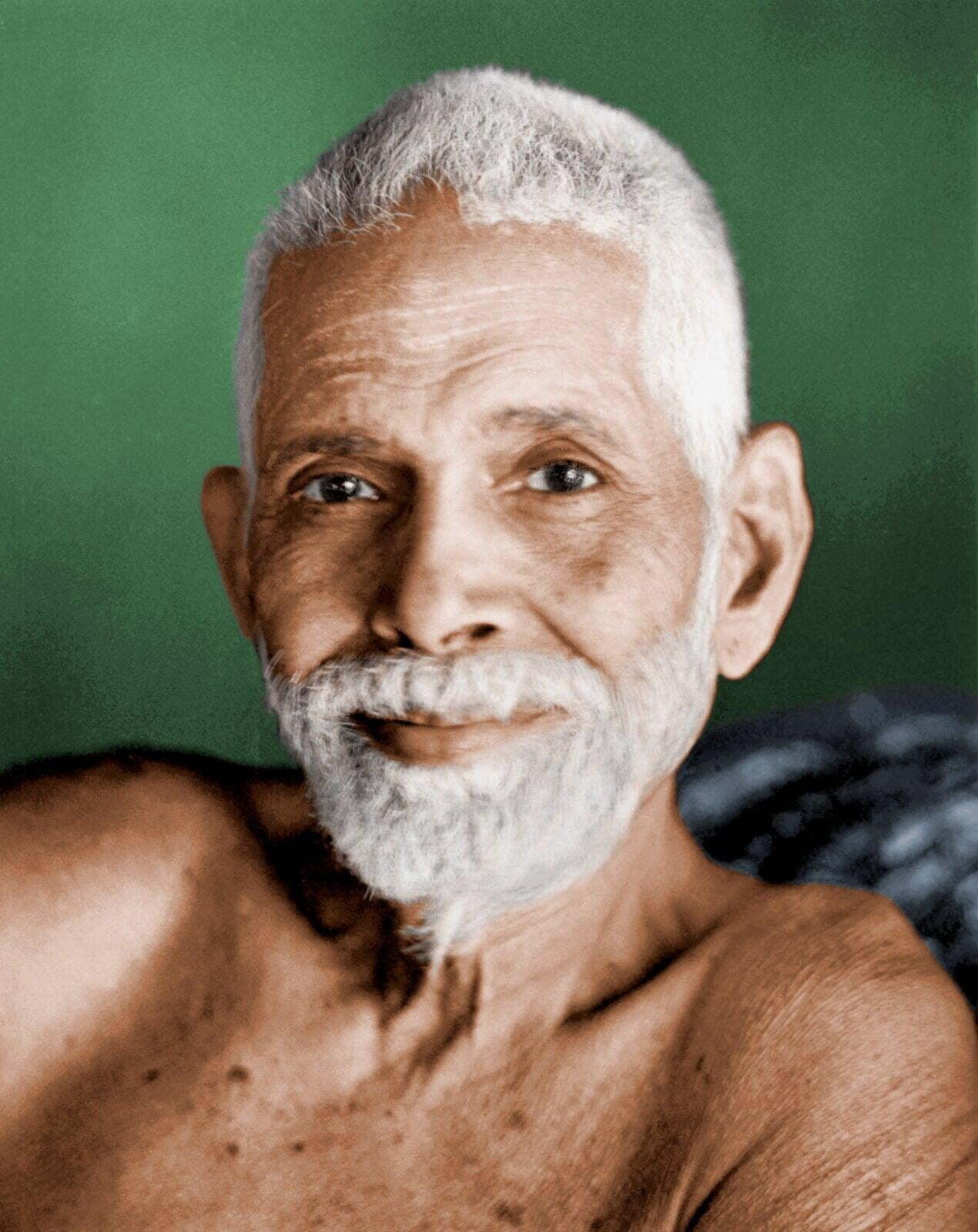Grace
D.: Is not grace the gift of the Guru?
M.: God, Grace, and Guru are all synonymous and also eternal and immanent. Is not the self already within? Is it for the Guru to bestow it on his look? If a guru thinks so, he does not deserve the name.
The books say that there are so many kinds of initiations—by hand, by touch, by eyes, and by mind. They also say that the Guru makes some rites with fire, water, japa, mantras, etc., and call such fantastic performances Initiation, as if the disciple becomes ripe only after such processes are gone through by the Guru.
If the individual is sought, he is nowhere to be found. Such is the Guru. Such is Dakshinamurti. What did he do? He was silent; the disciples appeared before him. He maintained silence; the doubts of the disciples were dispelled, which means that they lost their individual identities. That is wisdom, and not all the verbiage usually associated with it.
Silence is the most potent form of work. However vast and emphatic the scriptures may be, they fail in their effect. The Guru is quiet, and peace prevails in all. His silence is vaster and more emphatic than all the scriptures put together. These questions arise because of the feeling that, having been here so long, heard so much, and exerted so hard, one has not gained anything. The work proceeding within is not apparent. In fact, the Guru is always within you.
D.: Does Bhagavan give initiation?
M.: Silence is the best and most potent initiation. That was practiced by Sri Dakshinamurti. Touch, look, etc. are all of a lower order. Silence changes the hearts of all. There is no guru and no disciple. The ignorant confounds his body with the self, and so he takes the other’s body for the guru. But does the Guru think his body is the self? He has transcended the body. There are no differences for him. So the ignorant cannot appreciate the standpoints of the guru and the disciple.
D.: Vivekananda has also said that silence is the loudest form of prayer.
M.: It is so, for the seeker’s silence. The Guru's silence is the loudest instruction. It is also grace in its highest form. All other initiations, e.g., touch and look, are derived from silence. They are therefore secondary. Silence is the primary form. If the Guru is silent, the seeker’s mind gets purified by itself.
Later, a passage from the Yoga Vasishtha was read out before Sri Bhagavan, indicating initiation by look and initiation by touch.
Sri Bhagavan observed: Dakshinamurti observed silence when the disciples approached Him. That is the highest form of initiation. It includes the other forms. There must be a subject-object relationship established in the other initiation. First, the subject must emanate, and then the object. Unless these two are there, how is one to look at the other or touch him? Initiation by silence is the most perfect; it comprises looking, touching, and teaching. It will purify the individual in every way and establish him in reality.
At the same time, the importance of initiation and Sri Ramana Maharshi’s affirmation of the same can be understood in the following conversation.
D: “Can anyone get any benefit from repeating sacred syllables (mantras) picked up casually?
M.: “No. He must be competent and initiated in such mantras.” Maharshi illustrated this with the following story: A king visited his premier at his residence. There, he was told that the Premier was engaged in the repetition of sacred syllables. The King waited for him and, upon meeting him, asked what the words were. The Premier said that it was the holiest of all, Gayatri. The King desired to be initiated by the Premier. But the Premier confessed his inability to initiate him. Therefore, the King learned it from someone else, and after meeting the Minister later, he repeated the Gayatri and wanted to know if it was right. The minister said that the mantra was correct, but it was not proper for him to say it. When pressed for an explanation, the minister called to a page close by and ordered him to take hold of the king. The order was not obeyed. The order was often repeated and still not obeyed. The King flew into a rage and ordered the same man to hold the minister, and it was immediately done. The minister laughed and said that the incident was the explanation required by the king. “How?” asked the King. The Minister replied, “The order was the same, and the executor was also, but the authority was different. When I ordered, the effect was nil, whereas when you ordered, there was an immediate effect. Similarly with mantras.”
Mr. MacIver had an interview with Sri Bhagavan and spoke about initiation.
Sri Bhagavan asked: What is this initiation? After a pause, he continued, “Initiation is of various kinds, by word, by sight, by touch, and so forth.”
D.: Bhagavan’s is a silent initiation, is it not?
M.: Yes, this is the highest form of initiation.
D.: Is it applicable to the path of inquiry only?
M.: All the different paths are included in the path of inquiry.
After a pause, Sri Bhagavan spoke to the effect that people who come here are brought by some mysterious power that will look to their needs. The conversation practically ended with this.
D. How is the Guru found?
M. God, who is immanent, in His grace takes pity on the loving devotee and manifests Himself according to the devotee’s development. The devotee thinks that he is a man and expects a relationship between two physical bodies. But the Guru, who is God or the Self incarnate, works from within, helps the man see the error of his ways, and guides him in the right path until he realizes the Self within.
D. What should the devotee do then?
He has only to act up to the words of the master and work within. The Master is both ‘within’ and ‘without’, so He creates conditions to drive you inward and, at the same time, prepares the ‘interior’ to drag you to the center. Thus, He gives a push from ‘without’ and exerts a pull from ‘within’, so that you may be fixed at the center.
D. What is a guru’s grace? How does it lead to self-realization?
M. Guru is the self. Sometimes in his life, a man becomes dissatisfied with it, and, not content with what he has, he seeks the satisfaction of his desires through prayer to God, etc. His mind is gradually purified until he longs to know God, more to obtain His grace than to satisfy his worldly desires. Then, God’s grace begins to manifest. God takes the form of a guru and appears to the devotee, teaches him the truth, and, moreover, purifies his mind through association. The devotee’s mind gains strength and is then able to turn inward. Through meditation, it is further purified, and it remains still without the least ripple. That calm expanse is the self.
The Guru is both ‘external’ and ‘internal’. From the ‘exterior’ he gives a push to the mind to turn inward; from the ‘interior’ he pulls the mind towards the self and helps in the quieting of the mind. That is Guru’s grace. There is no difference between God, the Guru, and the Self.
You think that the world can be conquered by your own efforts. When you are frustrated externally and are driven inward, you feel, ‘Oh! There is a power higher than man!’
The ego is like a very powerful elephant that cannot be brought under control by anything less powerful than a lion, which, in this instance, is none other than the Guru, whose very look makes the elephant-like ego tremble and die.
You will know in due course that your glory lies where you cease to exist. In order to gain that state, you should surrender yourself. Then the Master sees that you are in a fit state to receive guidance, and He guides you.
D. How can I obtain grace?
M. Grace is the self. That is also not to be acquired; you only need to know that it exists.
The sun is only bright. It does not see darkness. Yet you speak of darkness fleeing on the sun’s approach. So also the devotee’s ignorance, like the phantom of darkness, vanishes at the sight of the Guru. You are surrounded by sunlight, yet if you see the sun, you must turn in its direction and look at it. So also, grace is found by the proper approach you take, though it is here and now.
D. Can Grace hasten ripeness in the seeker?
M. Leave it all to the master. Surrender to Him without reserve.
One of two things must be done: either surrender yourself because you realize your inability and need a higher power to help you; or investigate the cause of misery, go into the source, and so merge into the self. Either way, you will be free from misery. God or Guru never forsakes the devotee who has surrendered himself.
The main type of instruction given by Ramana Maharshi was silence, as it was with Dakshinamurthy of old. Divine bliss permeated those who sat around him. In this silence, the doubts of his devotees were cleared, and their questions were either answered or faded away, ceasing to exist. This silence was, and is, a dynamic force, eternal and universal in nature.

